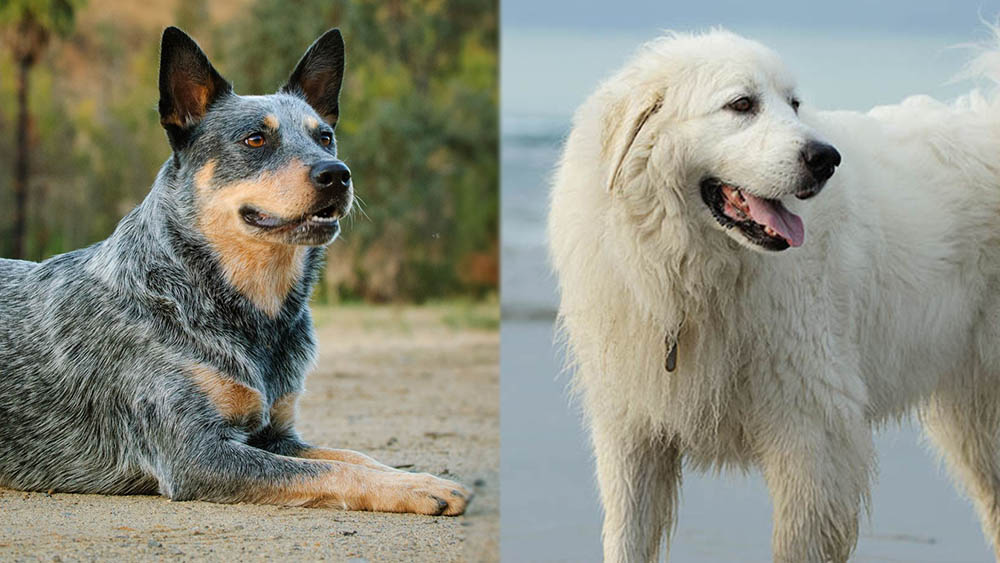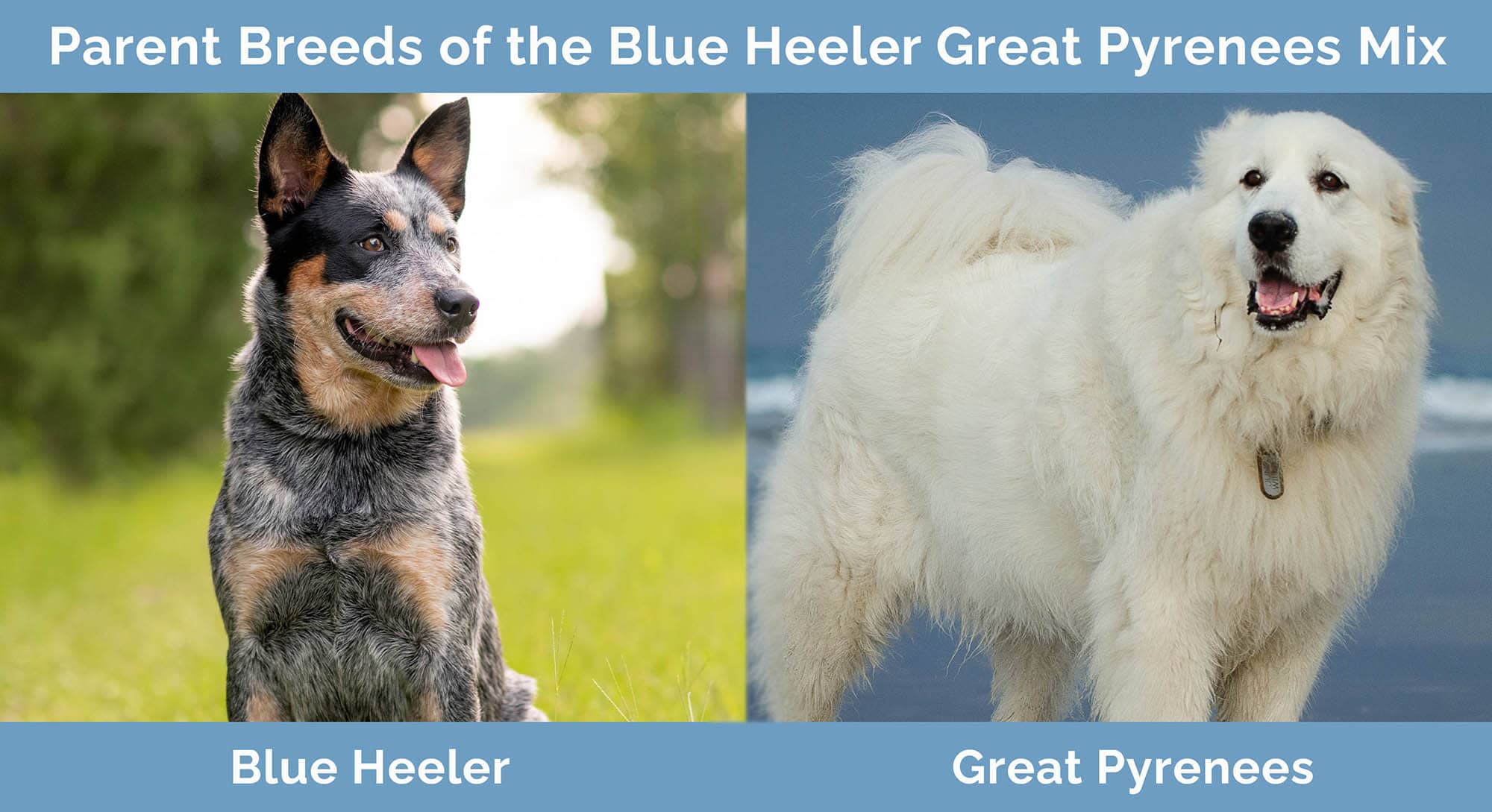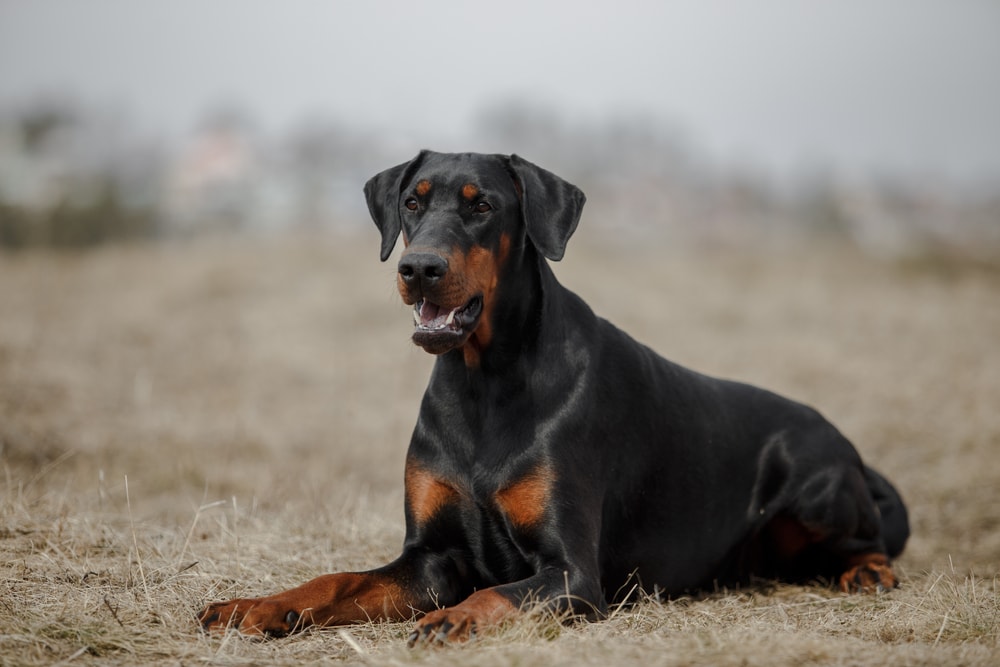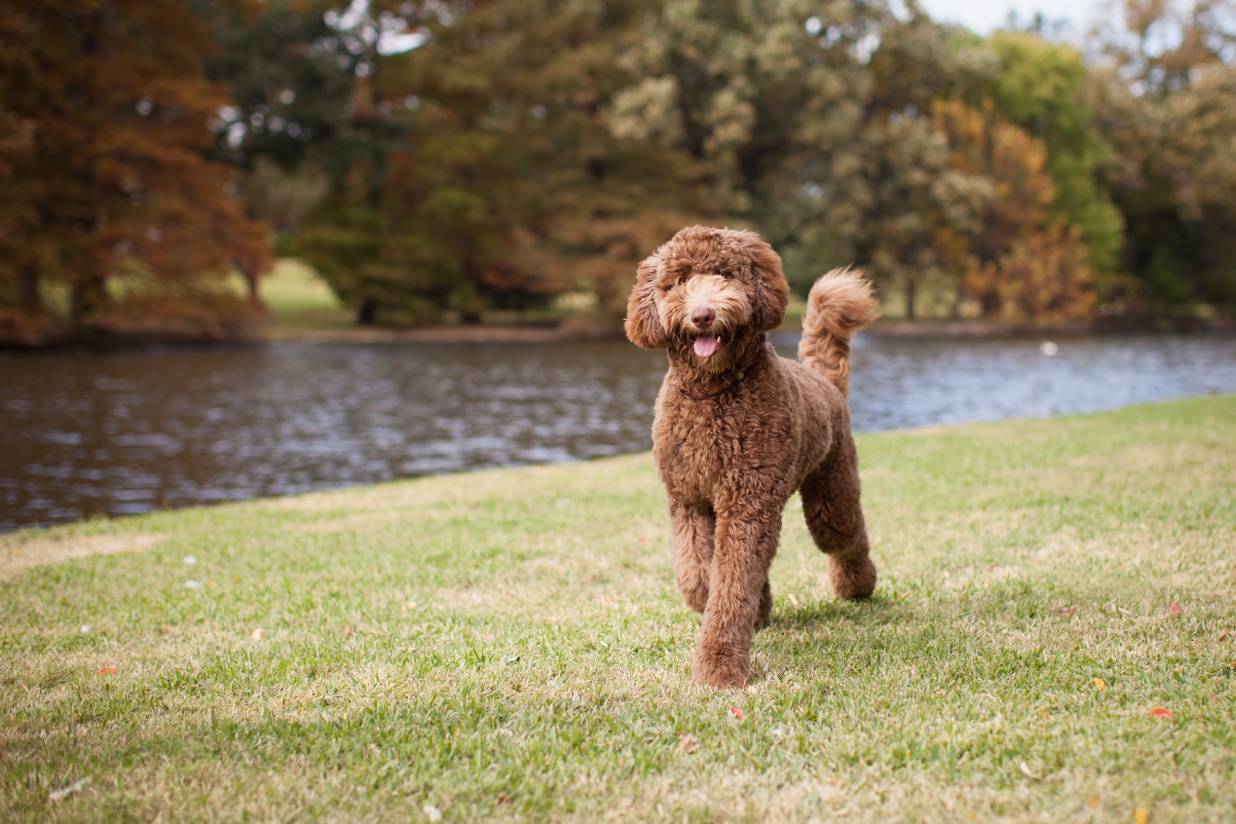Blue Heeler Great Pyrenees Mix: Pictures, Care Guide, Temperament, & Traits
By Hanh Duong
Updated on

Click to Skip Ahead
Are you considering adding a Blue Heeler Great Pyrenees mix to your family? This pooch is not only clever and devoted but also incredibly friendly. However, before you make the big decision, you should keep some crucial things in mind. This post will give you a beginner’s guide to the Blue Heeler Great Pyrenees mix, packed with helpful information on diet, training, exercise, and how to properly care for your new companion.
Breed Overview
| Height: | 18–33 inches |
| Weight: | 61–100 pounds |
| Lifespan: | 10–16 years |
| Colors: | White, black and tan, black and white, tricolored coats (black and white and tan/brown) |
| Suitable for: | House with a fenced yard, active families, runners, farmers |
| Temperament: | Loyal, fearless, smart, protective, mischievous, athletic, energetic, stubborn, independent |
Two amazing dog breeds were combined to create a real-life superhero of a dog—the Blue Heeler Great Pyrenees mix. The Blue Heeler was developed in the 19th century in Australia to help farmers with dogs for herding and driving cattle. This breed is known for protective instincts, athleticism, and excellent herding abilities. On the other hand, the Great Pyrenees hail from the mountains of France and were used for centuries to guard flocks of sheep from predators. They’re gentle giants who are patient and good-natured with kids.
The mix of these two breeds created a dog that’s not only an excellent herder but also a fierce protector. With the size and protective nature of the Great Pyrenees and the athleticism of the Blue Heeler, this cross canine is genuinely one of a kind. Whether you’re looking for a loyal companion or a watchful guard dog, this breed has got you covered.
Blue Heeler Great Pyrenees Mix Characteristics
Blue Heeler Great Pyrenees Puppies
This unique hybrid breed can have various attributes, but one thing’s for sure: they’ll grow up to be big dogs just like their parents. And speaking of their parents, the Great Pyrenees usually pass on their coat color to their offspring. So, expect to see some black, white, and tan pups. But don’t be surprised if you see some tricolored coats as well, just like the Blue Heeler.
Now, if you’re thinking about getting one of these pooches, make sure to choose a reputable breeder. A trustworthy breeder will give you all the information you need about the puppy’s parents, including their health history. Let’s make sure these pups are raised with love and care!

Temperament & Intelligence of the Blue Heeler Great Pyrenees
Are These Dogs Good for Families? 👪
Imagine having a furry friend who is both a loving companion and a fierce protector of your home. That’s what you get with a Blue Heeler Pyrenees mix. These canines possess natural herding instincts, which make them excellent watchdogs and guard dogs.
They are loyal, gentle, and affectionate with their pack, but don’t let their mild manners fool you. They will not hesitate to defend their loved ones and territory if threatened. However, it’s important to note that without proper socialization and training, these dogs may display behavior towards strangers such as nipping. So, give your Blue Heeler Pyrenees mix the love, care, and training they deserve to keep them happy and healthy.
Does This Breed Get Along with Other Pets? 🐶 😽
Socializing your Blue Heeler Great Pyrenees mix from an early age is crucial, as this can significantly impact their ability to get along with cats and other dogs. When properly socialized, they are more likely to develop positive relationships with these companions. However, it’s important to note that due to their strong prey drive, they may not be compatible with smaller pets such as hamsters or rabbits.
Things to Know When Owning a Blue Heeler Great Pyrenees:
Food & Diet Requirements 🦴
You may be wondering what to feed your little bundle of joy. Well, the answer is simple: high-quality, brand-name dog food is the way to go. But keep in mind to choose large-breed foods for your mixed canine.
Sharing your food with your furry friend may seem tempting, but it is not recommended. Incorrect food can cause teeth and bone problems, vitamin and mineral imbalances, and even lead to obesity and picky eating habits. And, of course, always remember to keep fresh and clean water available.
You can also mix their food with premium-quality dry food, some broth, or canned food. And if you want to spoil your furry friend with a bit of extra treats, you can give them cooked eggs, fruits, and veggies. Just ensure the treats don’t make up more than 10% of their daily food intake.
Exercise 🐕
Dogs require physical activity to stimulate their minds, burn calories, and avoid boredom, which can sometimes lead to destructive behaviors. Supervised playtime and games can provide an excellent outlet for your dog’s natural instincts to dig, herd, chew, retrieve, and chase. These activities can help alleviate anxiety and stress while providing a fun and engaging way for your pet to stay active.
In addition to playtime, it is essential to make sure that your dog gets long daily walks. These walks help to strengthen their muscles, improve cardiovascular health, and provide mental stimulation as they explore their surroundings. Overall, by offering a variety of activities that cater to your dog’s instincts and needs, you can help them maintain a healthy and happy lifestyle while also strengthening your bond with your furry companion.
Training 🎾
To ensure your puppy behaves well as an adult, you need to discourage any unwanted behavior early on. Many owners struggle with uncontrolled dogs between 6 and 18 months old due to a lack of training.
Attending a training class can be a fun way for new owners to learn the right approach to training. It’s also crucial to expose your dog to positive experiences with other canines and people from a young age to prevent behavioral issues.
Grooming ✂️
As a dog owner, you want your furry friend to have a healthy and shiny coat. To make sure your pup looks and feels their best, it’s crucial to regularly brush their hair to remove any loose fur and prevent mats from forming. This is especially vital for dogs with thick hair that tends to get tangled easily.
Not only do mats look unsightly, but they can also make your dog uncomfortable and even lead to skin infections. To prevent this, use electric clippers instead of scissors to remove any mats, as this will avoid accidentally cutting the skin underneath.
Giving your pup a bath with a pet shampoo every now and then is also essential for maintaining healthy skin and fur. Just be careful not to overdo it, as too much washing can dry out their skin and hair. Most dogs only need a bath once a month, but this can vary depending on the time of year and weather conditions.
Health Conditions 🏥
- Lens Luxation
- Progressive Retinal Atrophy
- Arthritis
- Cataracts
- Skin problems
- Hip dysplasia
- Elbow dysplasia
- Bone cancer
Male vs Female
Typically, male dogs are larger and require more assertive training. They make great family pets and can adjust quickly to various situations. However, make sure to provide your males with a secure living area, especially if they are not neutered.
Opposite-sex dogs usually get along better. When males are together, they tend to challenge each other’s status in the pack, which can lead to disagreements. Two females may have an easier time coexisting, but there can still be issues.
3 Little-Known Facts About the Blue Heeler Great Pyrenees
1. The Blue Heeler Is Smart
All shepherds are born with sharp minds, but some are simply remarkable! While the Border Collie is often hailed as the most brilliant breed, have you heard of the Blue Heeler?
What makes the Blue Heeler stand out is their intelligence, dedication, and work ethic. They are quick learners and are a joy to train. In fact, you won’t have to work as hard as you would with other breeds. Once they master obedience training, the sky’s the limit. You can teach them anything from fetching a ball to performing complex tricks.
2. The Great Pyrenees Goes by Several Names
Did you know that the magnificent breed known as the Great Pyrenees goes by different names depending on where you are in the world? In the United States, they’re simply referred to as the Great Pyrenees, while in the United Kingdom and Europe, they’re called the Pyrenean Mountain Dog. If you find yourself in France, you might hear it being called Le Chien des Pyrenees or Le Chien de Montagne des Pyrenees.
3. There Is a National Club for the Great Pyrenees
The American Kennel Club officially recognized the Great Pyrenees Club of America as the only national club for the breed in 1935. Ever since, they have been excellent at representing and promoting the breed across the United States.
This nonprofit organization does it all, from providing in-depth knowledge about the breed to organizing exciting competitions and events to rescuing and finding homes for Great Pyrenees in need. They also ensure that the breed standards are maintained at all times, ensuring that every Great Pyrenees is the best they can be.
Conclusion
Are you on the lookout for a furry companion who can double up as a reliable working dog? Look no further than the Blue Heeler Great Pyrenees mix! These charming canines are a delightful cross between the Blue Heeler and the Great Pyrenees. While their appearance may vary, they are generally large, energetic, and full of life.
Now, whether you are seeking a loyal best friend who can keep you company on long hikes or a skilled herding partner to help manage your livestock, this designer dog can be a great choice for you.
However, it’s essential to note that this hybrid might not suit everyone, especially if you are not an experienced owner. So, before you bring one of these gentle giants home, take some time to familiarize yourself with the unique challenges and joys of owning such a magnificent pet.
Featured Image Credit: everydoghasastory, Shutterstock















